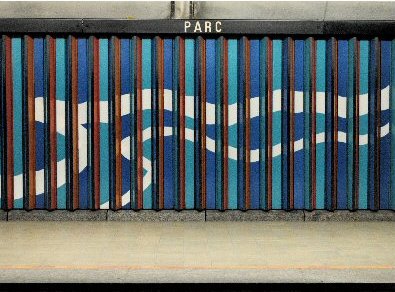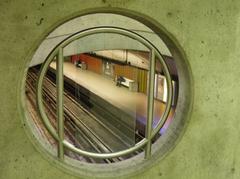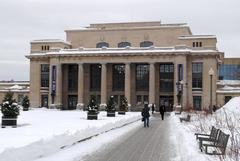
Parc in Montreal: Visiting Hours, Tickets, and Historical Sites Guide
Date: 15/06/2025
Introduction
Montreal, Canada is celebrated for its cultural vibrancy, historical depth, and inviting green spaces. Among the city’s most beloved parks, Parc du Mont-Royal, Parc La Fontaine, and Parc Jean-Drapeau stand out for their rich stories, iconic landmarks, and year-round recreational opportunities. This detailed guide will help you navigate their history, significance, main attractions, visiting hours, ticketing information, accessibility, travel tips, and more—ensuring you make the most of your Montreal park experience.
Table of Contents
- Introduction
- Parc du Mont-Royal
- Parc La Fontaine
- Parc Jean-Drapeau
- Comparative Insights: Major Montreal Parks
- Summary & Final Tips
- References
Parc du Mont-Royal
Historical Background
Parc du Mont-Royal—“the mountain” to locals—dominates Montreal’s skyline and heritage. Explorer Jacques Cartier named the mountain in 1535, and it later gave Montreal its name (mtl.org). Frederick Law Olmsted, the famed designer of New York’s Central Park, created Parc du Mont-Royal in 1876 as a green sanctuary from industrial growth (mtl.org; ameriquefrancaise.org). The park’s establishment reflected a growing public demand for accessible urban green spaces. In 2005, Quebec’s highest heritage status was granted to Mont-Royal, ensuring its protection (montreal2.qc.ca).
Cultural Significance
Mont-Royal is a symbol of Montreal’s identity, long serving as a communal gathering place and a site of spiritual and cultural importance—including for Indigenous peoples. In 2017, the Outremont summit was renamed Tiohtià:ke Otsira’kéhne in recognition of its First Nations significance (mtl.org). Today, the park is also recognized for its biodiversity, with city initiatives expanding its green spaces and ecological resilience (projetmontreal.org).
Main Attractions
- Kondiaronk Belvedere & Mount Royal Chalet: The city’s best panoramic view, with a nearby Beaux-Arts chalet (café, restrooms) (mtl.org).
- Olmsted Trail: Gently winding, accessible path for walking, jogging, and cycling, open year-round (mtl.org).
- Mount Royal Cross: A 31-meter illuminated cross, visible citywide, marking a 1643 pledge by Paul de Chomedey (mtl.org).
- Beaver Lake (Lac aux Castors): Man-made lake for summer boating, winter skating, and snow tubing (tourbytransit.com).
- Smith House: Visitor center and tour departure point (closed for renovations Dec. 2024–Mar. 2026) (montreal.ca).
- Tam-Tams du Mont Royal: Weekly Sunday drumming festival at the Sir George-Étienne Cartier Monument (mtl.org).
- Historic Cemeteries & Institutions: Final resting place of notable figures and home to key institutions (montreal2.qc.ca).
Activities & Seasonal Highlights
- Over 8 km of walking trails and 3 km of snowshoe trails (montreal.ca)
- Cross-country skiing, skating, tobogganing in winter (tourbytransit.com)
- Birdwatching: 100+ species recorded (mtl.org)
- Picnicking, meditation, and guided nature retreats (mtl.org)
Practical Tips
- Hours: Daily, 6:00 AM–midnight. Free entry.
- Facilities: Restrooms at Chalet, Beaver Lake Pavilion, Parc Jeanne-Mance. Seasonal cafés and snack bars (mtl.org; montreal.ca).
- Getting There: Metro (Peel, Mont-Royal, Laurier), bus, car (paid parking), BIXI bike (tourbytransit.com; montrealsecret.co).
- Accessibility: Olmsted Trail and main viewpoints are accessible. Some trails are steep or unpaved.
- Responsible Tourism: Respect biodiversity, clean up after picnics, and be mindful of cultural heritage (mtl.org; projetmontreal.org).
FAQ
- Hours? 6:00 AM–midnight, daily.
- Entry fee? Free.
- Dogs? Allowed, leashed.
- Best time to visit? Spring–autumn for festivals; winter for snow sports.
- Wheelchair accessible? Main paths and facilities are, though some areas are steep.
- Equipment rental? At Beaver Lake Pavilion for seasonal activities.
- Guided tours? From Smith House (closed Dec. 2024–Mar. 2026).
Nearby Attractions
- Parc Jeanne-Mance: Sports fields and open space (tourbytransit.com)
- Plateau Mont-Royal: Renowned for cafés, street art, boutiques (montrealsecret.co)
- Cultural Institutions: McGill University, Musée des Beaux-Arts, Saint Joseph’s Oratory (tourbytransit.com)
Parc La Fontaine
Historical Evolution
Parc La Fontaine, spanning 34–40 hectares in the Plateau Mont-Royal, evolved from Logan Farm (gifted in 1845) to a military training ground, then public park by 1874 (Wikipedia; Montreal.ca). Artificial ponds, a waterfall, and a charming bridge were added in 1900, with the park named after Louis-Hippolyte La Fontaine. Its facilities expanded in the 20th century, including the notable chalet-restaurant and amphitheater (Wikipedia; CBC).
Cultural & Social Significance
La Fontaine is a cultural gathering spot, hosting free summer events at the open-air Théâtre de Verdure and year-round programming at Calixa-Lavallée Pavilion and Espace La Fontaine (Montreal.ca; Montreal Visitors Guide). Monuments throughout the park honor figures from Montreal’s history (Wikipedia).
Main Features
- Landscaped Ponds & Waterfalls: Interconnected ponds and a picturesque waterfall provide habitat for swans and ducks; turn into skating rinks in winter (Montreal.ca; MTL.org).
- Théâtre de Verdure: Open-air amphitheater with free summer concerts and performances (Montreal Visitors Guide).
- Calixa-Lavallée Pavilion & Espace La Fontaine: Cultural center and café with exhibitions (Wikipedia).
- Recreational Facilities: Playgrounds, children’s cycling track, baseball diamonds, soccer fields, tennis courts, bike paths, and picnic areas (TourbyTransit).
- Public Art & Monuments: Sculptures and monuments throughout the park (Wikipedia).
Seasonal Activities
- Spring/Summer: Picnics, sunbathing, cycling, birdwatching, and cultural events (MTL.org).
- Autumn: Stunning fall foliage for photography.
- Winter: Outdoor skating, sledding, and snowshoeing (MTL.org; TourbyTransit).
Visitor Information
- Hours: Daily, 6:00 AM–11:00 PM. Free entry (Montreal.ca).
- Accessibility: Wheelchair-friendly paved paths; some uneven surfaces (Montreal.ca).
- Getting There: Metro (Sherbrooke), buses, BIXI bikes, limited street parking (TourbyTransit).
- Amenities: Restrooms, café, skate rentals in winter (MTL.org).
- Rules: Dogs leashed, no alcohol outside events, seasonal portable toilets, event calendar online (Montreal.ca).
FAQ
- Hours? 6:00 AM–11:00 PM, daily.
- Entry fee? Free.
- Dogs? Allowed, leashed.
- Best time to visit? Spring–fall for outdoor activities, winter for skating.
- Accessible? Yes, with paved paths and accessible restrooms.
- Events tickets? Most events are free; some may require tickets.
Parc Jean-Drapeau
Historical Evolution
Parc Jean-Drapeau spans two islands—Île Sainte-Hélène and Île Notre-Dame—in the St. Lawrence River. Originally a military site and later a public park, the islands gained global fame during Expo 67, the World’s Fair, which brought futuristic architecture and international pavilions (The Main; Parc Jean-Drapeau History). The park continued to evolve with Olympic venues and the Formula 1 Circuit Gilles-Villeneuve (The Canadian Encyclopedia).
Cultural Impact
A symbol of Montreal’s ambition and multiculturalism, the park’s Expo 67 legacy endures in landmarks like the Biosphere. It is also an ecological haven, balancing habitat conservation with major events (The Main).
Main Attractions
- Biosphere Environmental Museum: Former US Expo pavilion, now an interactive climate museum (Parc Jean-Drapeau Attractions).
- Casino de Montréal: Canada’s largest casino, in the former French and Quebec pavilions (The Canadian Encyclopedia).
- Circuit Gilles-Villeneuve: Formula 1 track, open to cyclists/runners outside races (Parc Jean-Drapeau Activities).
- Jean-Doré Beach: Urban beach and water sports center (Parc Jean-Drapeau Beach).
- La Ronde Amusement Park: Major theme park and fireworks festival venue (The Canadian Encyclopedia).
- Floralies Gardens & Public Art: Themed gardens and sculptures (MTL.org).
- Festivals: Canadian Grand Prix, Osheaga, Piknic Électronik, LASSO, and more (The Main).
Visiting Hours & Tickets
- Hours: Daily, 6:00 AM–11:00 PM. Free park entry; tickets for select attractions/events (Parc Jean-Drapeau).
- Tickets: Required for Biosphere, Casino, La Ronde, Grand Prix, and festivals; purchase online or at entrances.
Activities by Season
- Summer: Beach, water sports, cycling, running, festivals, gardens (Parc Jean-Drapeau Beach).
- Fall: Foliage hikes, birdwatching.
- Winter: Cross-country skiing, skating, snowshoeing, winter festivals (Parc Jean-Drapeau Winter).
- Spring: Walking, cycling, wildflowers, early festivals.
Visitor Tips
- Getting There: Metro (Jean-Drapeau), car (parking lots P10, P11), bike paths, seasonal river shuttles (Parc Jean-Drapeau Info).
- Getting Around: STM shuttles, walk/cycle paths, taxibus (Parc Jean-Drapeau Transportation).
- Amenities: Information centers, restrooms, bistros, snack bars, equipment rentals (Parc Jean-Drapeau Restaurants).
- Accessibility: Wheelchair-accessible trails and facilities.
- Sustainability: Leave No Trace, wildlife protection, recycling (Parc Jean-Drapeau Sustainability).
- Safety: Swim only in designated areas, dogs leashed, alcohol in licensed/event areas.
FAQ
- Hours? 6:00 AM–11:00 PM, daily; attractions may vary.
- Entry fee? Park is free; tickets required for attractions/events.
- Tickets? Online or on-site for attractions/events.
- Accessible? Yes, many facilities and trails.
- Pets? Dogs leashed; not allowed on Jean-Doré Beach.
- Transport? Metro, parking, bike, river shuttle.
Comparative Insights: Major Montreal Parks
| Feature | Parc Jean-Drapeau | Mount Royal Park | Parc La Fontaine | Parc Maisonneuve |
|---|---|---|---|---|
| Size (acres) | 662 | 470 | 84 | 190 |
| Major Events | Yes (F1, Osheaga) | Yes (Tam-Tams) | Some | Some |
| Aquatic Facilities | Yes (Beach, Pool) | No | Pond | No |
| Historical Landmarks | Yes (Expo 67, Fort) | Yes (Cross, Chalet) | No | No |
| Accessibility (Metro) | Excellent | Good | Good | Good |
| Year-Round Activities | Yes | Yes | Yes | Yes |
| Family-Friendly | Excellent | Excellent | Good | Excellent |
(Parc Jean-Drapeau, Timeout Montreal, PlanetWare)
Summary & Final Tips
Montreal’s parks—Parc du Mont-Royal, Parc La Fontaine, and Parc Jean-Drapeau—offer a window into the city’s history, culture, and natural beauty. Parc du Mont-Royal is a beloved urban retreat with stunning views, historical sites, and vibrant events. Parc La Fontaine charms with tranquil ponds, open-air theater, and family-friendly amenities. Parc Jean-Drapeau stands out for its scale, major festivals, and Expo 67 legacy.
All parks provide year-round recreation, accessible facilities, and public transit connections. For the best experience, check opening hours and event schedules, book tickets ahead for special attractions, and explore nearby neighborhoods like Plateau Mont-Royal and Old Montreal. Responsible tourism ensures these green spaces remain vibrant for generations.
Explore these iconic parks to discover the spirit of Montreal—where nature, history, and celebration meet. (mtl.org; montreal.ca; parcjeandrapeau.com)
References
- This is a sample text. (mtl.org)
- This is a sample text. (ameriquefrancaise.org)
- This is a sample text. (montreal.ca)
- This is a sample text. (parcjeandrapeau.com)
- This is a sample text. (parcjeandrapeau.com)
- This is a sample text. (Wikipedia)
- This is a sample text. (The Main)
- This is a sample text. (Timeout Montreal)
- This is a sample text. (PlanetWare)






























































































































